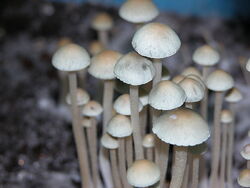| Substrates: | manure, straw |
| Synonyms | |
| |
| Scientific Classification | |
| Kindom: | Fungi |
| Phylum: | Basidiomycota |
| Class: | Hymenomycetes |
| Order: | Agaricales |
| Family: | Bolbitiaceae |
| Genus: | Panaeolus |
| Species: | Cyanescens |
Panaeolus cyanescens (aka Copelandia cyanescens, Hawaiians, blue meanies, Pans and Pan cyans) is a hallucinogenic mushroom that contains psilocybin, psilocin, serotonin, and urea.
Characteristics[]
- Cap: 1.5-4 cm broad, bell-shaped to convex; surface smooth or sometimes cracked, not viscid, brown when moist, fading to grayish or whitish as it dries; margin often wavy or split in age. Flesh thin, bruising blue or bluish-green.
- Spore print: black; spores 12-14 x 8-11 microns, elliptical, smooth
- Bruising: blue or blue-green
- Gills: adnate to adnexed or seceding, gray to black, the faces usually mottled.
- Stipe: 6-12 cm long, 2-4 mm thick, equal or with a slight bulb at base, usually long and slender, smooth, pallid to yellowish, grayish, or pinkish, the base brownish or tinged flesh-color; bruising bluish at least somewhat when handled.
- Veil: absent
- Mycelium: Linear to cottony mycelia; white to off-white
Cultivation[]
Cyanescens is a species which have been commonly cultivated indoors (in an artificial environment) and outdoors.
Parameters[]
Spawn run
Primordia Formation
Fruit body Development
Substrates[]
Panaeolus cyanescens perform well with a combination of grain and manure substrates, but also grow well on straw.
Casing Layer[]
This species must be cased in order to fruit properly, but is otherwise considered easy to cultivate. Experience suggest that a thin casing layer (ie. 1cm thick) of pH balanced peat moss and vermiculite performs best.
Natural Habitat[]
Panaeolus cyanescens is a dung-loving species which grows in tropical and neotropical areas in both hemispheres. The fruit bodies grow solitary to widely scattered or in groups on or near dung in pastures. It has been reported in Hawaii, Louisiana, Mississippi, Florida, Texas, Australia, India, Mexico, Bolivia, the Philippines, Thailand, France, Brazil, the coastal regions of South Africa, and is probably more widely distributed.
Cultivation, consumption and the law[]
Because of the hallucinogenic chemicals panaeolus cyanescens manufacture, they are illegal to cultivate or posess since psilocybin and psilocin are listed as Schedule I drugs under the United Nations 1971 Convention on Psychotropic Substances.
References[]
